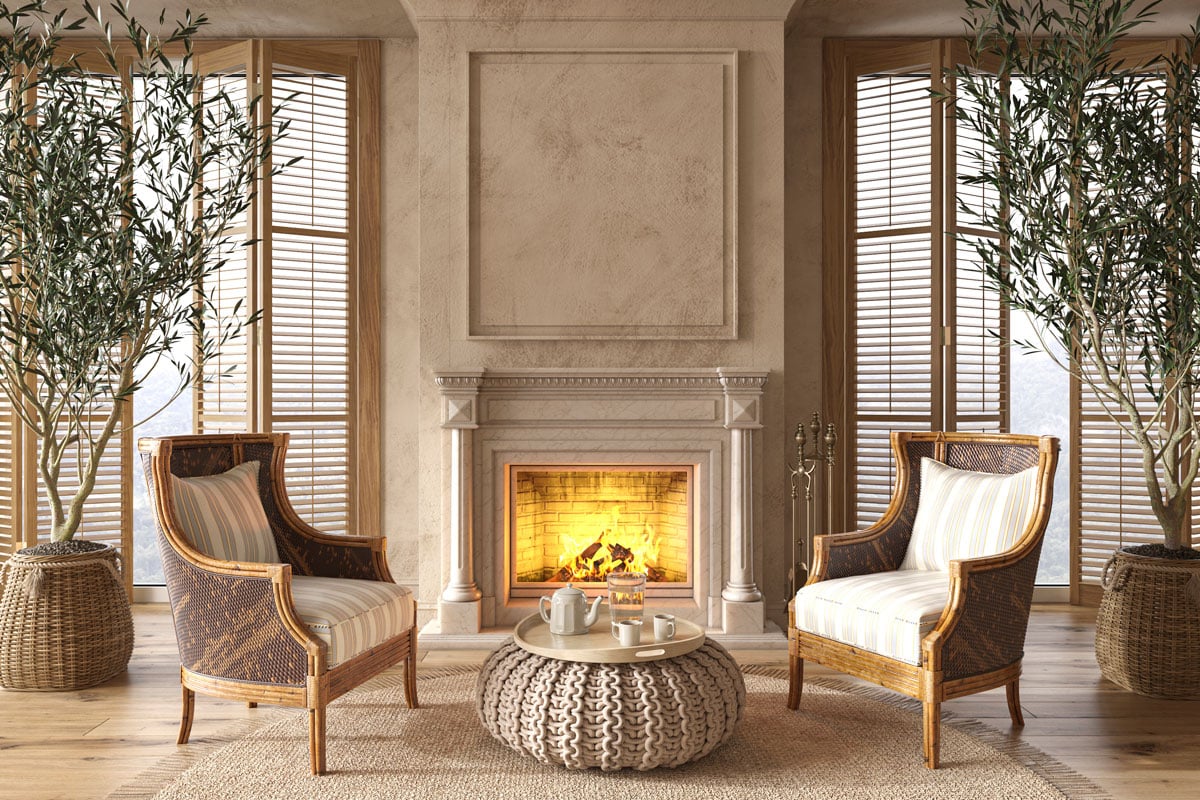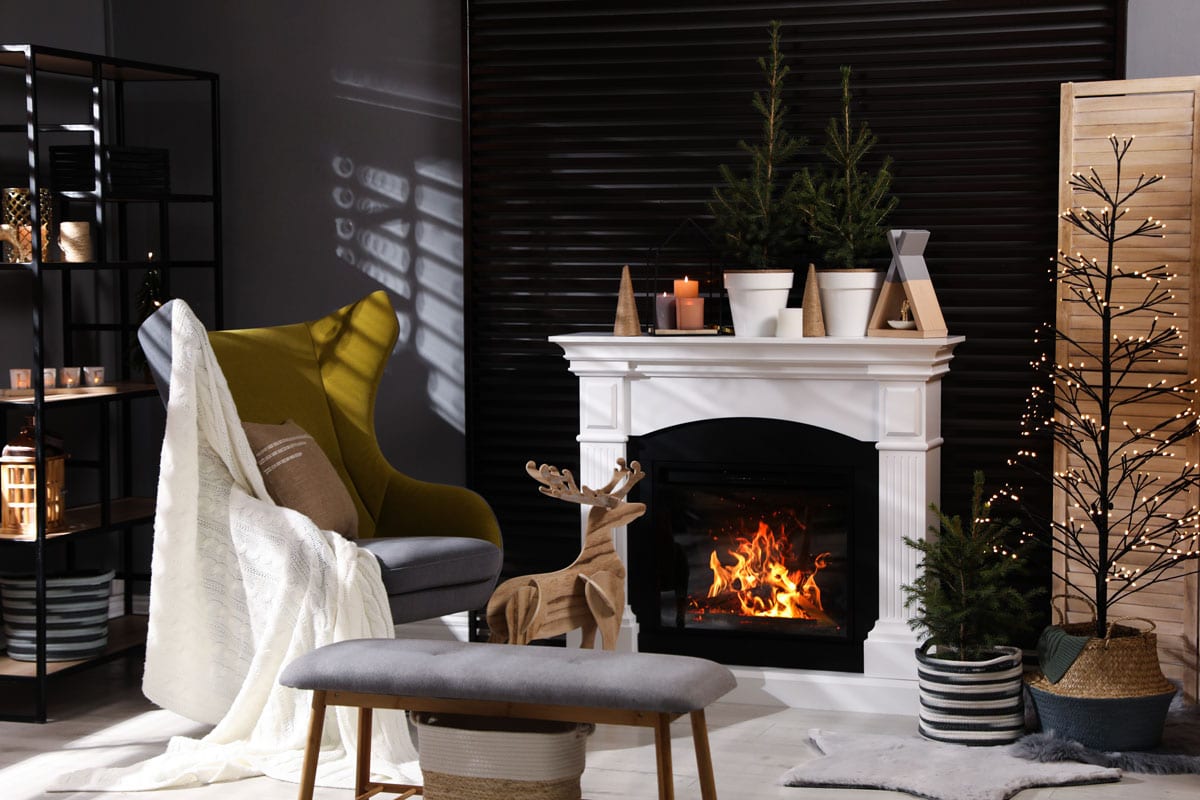You’re about to relax in front of your fireplace during a rainy evening. But you find out that water is seeping through the structure from the heavy rain. What can you do in this situation? We researched this concern for you, and here’s what we found.
A leaking fireplace can have different culprits. These underlying issues may range from old caulking to roof leaks. So, you should troubleshoot and search for the leak’s source first. Then, move forward with the repair job by using the correct method based on your findings. These solutions include:
- Sealing the chimney
- Installing a chimney cover
- Installing insulation
Continue reading as we talk about the different possible reasons why your fireplace leaks during rainy weather. We’ll also tackle some solutions to help reduce and stop this problem from reoccurring.

Why Is My Fireplace Leaking When It Rains?
Aside from dried caulking, a fireplace may also have other issues that cause it to leak during rainy weather. Some of these possible problems are:
Rain From The Top Of The Chimney
A relatively typical reason why water is coming down to the fireplace is that the chimney's top doesn't have protection. Installing a chimney cover may help in reducing or even eliminating this problem.
Structural Damage
An earthquake, a settling foundation, or a strong force on the fireplace's structure may cause it to crack or break. These gaps can cause water to seep into the fixture, causing moisture damage to it and its surroundings.
Condensation Buildup

Condensation occurs when: (1) the air in a particular location cools to its dew point, or (2) the airborne water particles become heavy or saturated that it visibly forms on nearby surfaces.
In the case of fireplaces, the warm air escaping from the structure and the cold air from the rain saturates the moist molecules. The result is condensation forming in and around the chimney, causing it to leak.
Roof Leaks

Sometimes the fireplace or the chimney isn’t the source of the leak but rather the roof is. Check for leaks coming from the ceiling. The moisture coming from that surface may get into the fireplace.
Gas Fireplace Leaks When It Rains

One of the relatively common culprits of water escaping from a gas fireplace when it rains is dried caulking. Generally, caulk lasts about 5 years. However, certain conditions like inclement weather may shorten the sealant’s lifespan.
How Do I Stop My Chimney From Leaking In The Rain?

Take note that the first step to fixing a leaking chimney is to troubleshoot the situation first. Once you find the source of the problem, you can move ahead with the appropriate course of action.
In this section, you’ll learn some possible solutions to repair a chimney leaking from the rain based on the source of the issue.
Seal The Chimney
If the leaks from your chimney come from dried caulk, you need to remove the old sealant before resealing it. You can do this initial step with a caulk remover. But if you don’t have access to that tool, follow these steps:
What You’ll Need
- Utility knife
- Plastic putty knife
- Citrus stripper
- Nylon brush
Step-By-Step Guide
- Use the utility knife and slide it along the edge of the old sealant to break the bond.
- Remove the rest of the caulking with the plastic putty knife.
- Repeat steps 1 and 2 as many times as necessary.
- Take out stubborn sealant by spraying it with the citrus-based stripper.
- Let the stripping solution sit for about 10 minutes.
- Remove any leftover caulking with the nylon brush.
Check out this caulk removal tool on Amazon.
You can also watch the video below for a visual guide on the steps above. It's important to note that this clip shows you how to remove caulking from a bathtub. Although the surface is different, the process should still be relatively similar to removing old sealant from a chimney and/or fireplace:
With the old sealant out of the way, reapply the new sealant onto those areas. Take note that you may also need to apply caulking on your chimney cover to achieve an airtight seal.
Watch the following video to gain additional insight into sealing a chimney:
Install A Chimney Cover
Also called a chimney cap, this fixture can help prevent rainwater from coming through the structure and into the fireplace. But keep in mind that different chimney covers exist for different chimney top sizes. So measure your chimney’s top first before finalizing your purchase to avoid unwanted expenses.
Plus, you’ll likely need to climb up to your house’s roof to access the chimney top. Make sure to practice proper safety by requesting help from another person to hold the ladder as you climb it. You may also install a safety harness and tie it around yourself. That way, you’ll still be safe if you slip while on the roof.
Once you have a chimney cover that fits and you complete the safety precautions, you can continue this procedure by following these steps:
What You’ll Need
- Chimney cover
- Socket wrench
Step-By-Step Guide
- Loosely place the cover on the chimney’s top while paying attention to the proper orientation.
- Tighten the screws on the cover’s corners with the socket wrench.
Check out this chimney cap on Amazon.
Watch this video if you need a visual guide for this process:
Prevent Condensation With Insulation
Insulation can help prevent condensation. But the amount of moisture controlled often depends on the insulation material used. So you may want to install relatively thick insulation if the leakage from your fireplace or chimney is fairly significant.
Here’s a quick overview of how to insulate the area in and around your fireplace:
Step-By-Step Guide
- Repair any existing issues in the fireplace area (e.g. cracks, efflorescence, and mold).
- Once fixed, remove the wall material surrounding the fireplace. Pay attention to your removal procedure so you won’t remove any supporting structures.
- Install a water barrier. Then, place and secure the insulation into the opening.
- Rebuild the removed section of the wall.
Check out this foam board insulation on Amazon.
You can also watch this video if you want to use spray foam to insulate around your fireplace:
How Much Does It Cost To Repair A Leaking Fireplace?
The costs to fix water leaking from a fireplace generally depend on the type and severity of the problem. But prepare to spend approximately $85 to $1,600 to complete the job. The overhead might also increase if you take advantage of professional services.
How Much Does It Cost To Replace A Fireplace?
Replacing a fireplace may have expenses that range from $2,500 to $11,000. But the costs often depend on certain factors such as the materials used for the construction and the structure’s type.
For instance, building a brick or stone veneer fireplace costs approximately $4,500. On the other hand, installing a pellet stove system might be a less expensive option, as you may only need to pay about $2,000.
But if you’re planning to replace your old fireplace with a gas model, prepare to spend about $4,300 to $12,000 for this project. Electric fireplaces might also be less costly than their gas counterparts, although you may need to pay extra money for monthly electricity bills.
What Is The Lifespan Of A Fireplace?

First, identify the type of fireplace in your abode to estimate its lifespan. Fireplaces like those made of bricks can last for over a century with proper care. But pre-fabricated fireplaces may only last about 10 to 15 years. Still, you may double the fireplace’s life if you follow a strict maintenance routine for it.
How Do You Maintain A Fireplace?
Take note that caring for your fireplace can help prevent issues like leakage during rain. Following a routine fireplace maintenance routine may also help extend the structure’s lifespan. So follow these tips to ensure you can make the most out of your fireplace for years:
- Clean the interior. Remove leftover ashes to improve smoke removal.
- Remove soot buildup. This material can even become a fire hazard if left alone.
- Only use the right wood. Put properly dried seasoned woods into the fireplace to help prevent moisture buildup.
Final Words

Remember, a fireplace can leak water when it rains because of different reasons. For instance, the structure might be prone to condensation or you need to install a chimney cover. Make sure to figure out the source of the problem to follow through with the appropriate solution.
If you liked this post and would want to learn about fixing other leaks, check out these great reads:



